The kettlebell swing is a unique fitness equipment, and it’s fun. You’re going to get to be explosive. The thing you have to learn is how to control that explosion and what body parts have to stay tight, what muscles are driving the entire swing movement.
If you don’t learn those things, then the swing exercise becomes an easy mechanism for injury risk. In that case, there are a lot of chances to hurt your lower back, knees, and your shoulder muscles.
We want to avoid all those things. So in this article, we’re going to tell you what muscles do kettlebell swings work. Also, we will cover our tips for targeting the right muscles. And we are going to show you why kettlebell exercises could be your secret weapon.
Let’s dive into it.
Jump to:
- Muscles Used in Kettlebell Swings
- The Posterior Chain
- What Muscles Are Used In Kettlebell Swing Variations
- Tips for Targeting the Right Muscles
- 5 Mistakes That Prevent You From Targeting the Right Muscles
- How to Identify Weak Muscles in the Kettlebell Swing
- Kettlebell Swing Benefits
- What Muscles Do Kettlebell Swings Work: FAQs
Muscles Used in Kettlebell Swings
The kettlebell swing is a great exercise to develop the posterior chain. What is the posterior chain reaching? It is the whole back side of your body. The primary muscle we are working on is the glutes. The glutes are the powerhouse of your body. They are most responsible for moving you in a powerful manner. So we want to get good at using our glutes.

The next thing is the hamstrings. In the swing exercise, you strengthen them in a lengthen eccentric position. As you come down in the swing, your hamstrings lengthen. And it helps strengthen. Also, it prevents injury risk. Because a lot of injuries are from stretching the hamstring muscles too far.
And then the third one is a combination. It’s your whole torso. It includes your abdominal muscles, obliques, and also your lower lumbar muscles as well as all the way up to your shoulder blades. And these are meant to help stabilize. So that it’s an isometric contraction. There’s no moving of your spine. And your knees have minimal bending. That is because we’re working the posterior chain.
The Posterior Chain
A better understanding of the posterior chain will hopefully give you a better understanding of what muscles do kettlebell swings work.
The posterior chain is not one thing, it’s a collection of body muscles that interact with each other. They’re interconnected through the fascia and your brain recruits them in a sequential way in order to achieve movements.
The Posterior Chain Groups
There are two posterior chain groups we want you to become familiar with.
The first is a center line. It starts in the skull, goes all the way down your spine, then goes into the low part of your back. It splits into your butt muscles and then goes down into your hamstrings, and calf muscles, and then down into your feet. It finishes up at your plantar fascia.
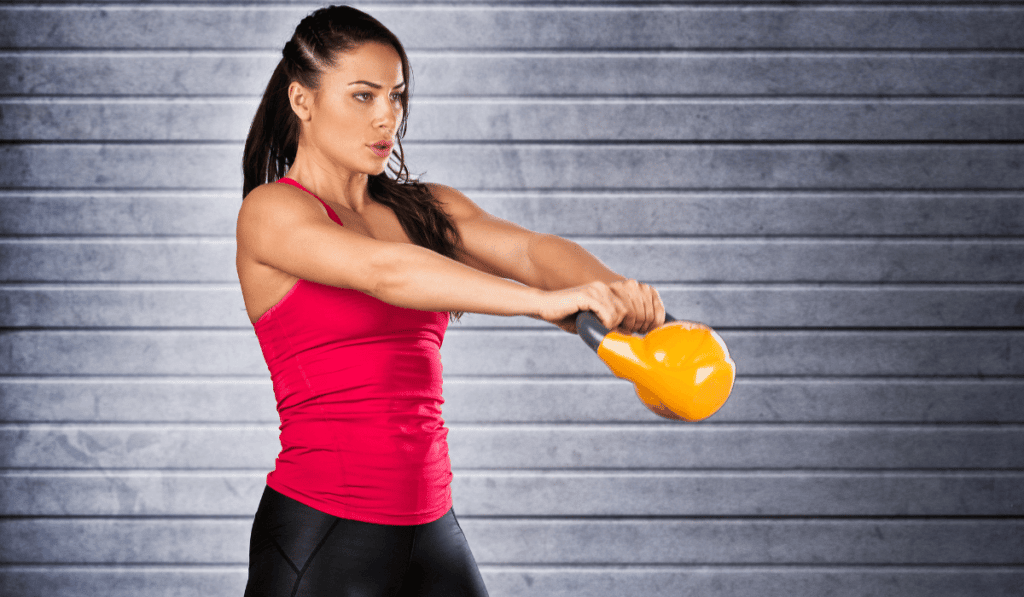
Now there’s a pair of posterior chain groups on either side. They are attached to your shoulders in your armpits. They come down and meet the center post of your chain in your low back region. So this area is a very high traffic area of forces. Here forces are going up and down, back and forth throughout this area. And then those forces continue down into your legs as well.
So, all three of these regions are crossing over. And they need to be moving with as much efficiency as possible. What often happens is weakness and poor motor recruitment of the posterior chain muscles.
Why Is The Posterior Chain Important?
This area can often become weakened. And the forces are being redistributed to other muscles. Muscles that aren’t designed to be recruited the way these muscles are. They are more the mobility muscles, not the stability muscles.

And so if you lose the ability to adequately recruit your stability muscles, which are part of the posterior chain, then your brain will start to recruit. Also, the brain will over-recruit the mobility muscles which fatigue faster. When they fatigue faster, you have aches and pains. And this is where it becomes uncomfortable.
And there are so many muscles down there, so it’s very difficult to identify what is the muscle. Because it isn’t a singular muscle. That’s a problem. It’s the lack of posterior chain recruitment. So we want to be working on exercises that train the posterior chains.

The Benefits of Training the Posterior Chain
As you train the posterior chain, then the brain can start to recruit all the muscles more efficiently. They can start loading them because they’re designed to be loaded. And as they start to load up these muscles then the brain and the nervous system begin to offload the mobility muscles. So they have a chance to rest and they’re not fatigued so fast.
And so, now the muscles that are designed to be loaded and have a hard time fatiguing (because they have strong endurance), are able to work better. That means the mobility muscles fatigue less. This will improve posture as well. So we don’t have to work on posture exercises as much, but we have to focus on improving the posterior chain.
So, you need to exercise the posterior chain in different ways. But the best way to train it is kettle swings. As a result, you’ll find a lot better functionality and a lot less muscle fatigue in your back.
What Muscles Are Used In Kettlebell Swing Variations
Double-Handed Kettlebell Swing
Since it is a hip hinge movement and you’re primarily working your posterior chain, you do want to feel your glutes, hamstrings, and core muscles. And your heart rate is probably going to come up if you’re giving the right power to the movement. Two hands are engaged on every rep at the same time.
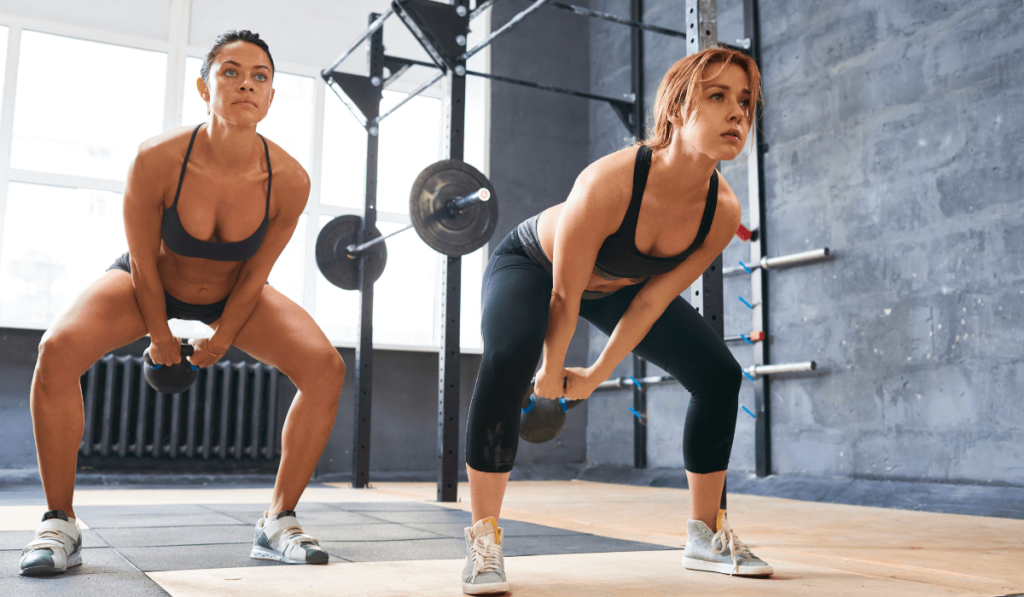
Single Arm Kettlebell Swing
After you’ve been working on your two-handed kettlebell swing exercise for a while, you may be looking to step the progression up a little bit. In this case, we’re going to be looking at a 1-armed kettlebell swing exercise. This adds a lot more core stability to control rotation and stay squared up. You’re going to have to fire off your obliques at the right time.
Since we’re holding the kettlebell with one hand at a time, the shoulder girdle is going to stay active and engaged keeping the kettlebell from flying away from you on every rep.
You can use the off hand to entrain with the kettlebell switch launching it back to amplify that backswing and then meeting the kettlebell handle at the apex of every rep. This keeps the timing element consistent with what you practiced in your two-handed kettlebell swing.
Alternating Kettlebell Swing
Another great kettlebell swing progression is the alternating single-arm swing. This is a lot of fun. Because not only does it build on what we developed in the single arm swing (all the rotational stability and the shoulder blade activation).
Now we have a rhythmic change from side to side. And not only does that give you an opportunity to balance out the work component rep after rep. It also creates a smooth transition from hand to hand. This opens the door to a lot of fun transitional movements as well as flows.
Once you get some kettlebell skills under your belt, a little flow action is a lot of fun.

So, in the alternating kettlebell single-arm swings, you load up mechanics and stay the same fundamentally. But you’re going to change your hands at the top. This highlights the benefit of that swing of the free arm and meeting the handle at the apex of the swing. It loads you up perfectly and times that hand change while the kettlebell is weightless at the top of each rep.
Regression: Chest Swing
If you’re having a challenge with the kettlebell swing, it’s great to have this drill in your back pocket. We call this the chest swing. And we’re usually going to use a lighter-weight or light-to-moderate-weight kettlebell for this drill. Because it’s about posture as much as anything else.
You’re going to take the base of the kettlebell at your belly below your sternum. We’re going to grab the kettlebell by the horns and roll the shoulders back exaggerating that proud chest posture. Take that nice wider-than-shoulder-width stance. Relax the knees. Spread those knees apart as you work that nice hinge mechanic and drive the hips through.
A lot of times with the kettlebell swing, timing and sequence are big issues. So take note, you can move slowly into the back position. And you can move slowly into the ended hip extended position. And at all times you’re stable and safe.
You can work on timing slowly on the way back and power on the way up. You can also work fast. As you do this, you can work on some of the more elusive components of any dynamic exercise.
Tips for Targeting the Right Muscles
Here are our tips for targeting the right muscles while performing kettlebell training sessions.
1. Start at a Deadlift Position
Make sure that you’re starting in a deadlift position and your kettlebell is between your ankle bones. Keep shoulders in.
2. Keep Hands Pull Outward
Picking the kettlebell up like you’re trying to break the handle in half. Engage your fingers.

3. Build the Momentum
Start with a small momentum to help get the movement going. And keep in mind this is a hip hinge movement and a hip thrust. Push your hips back letting the kettlebell carry you. And then thrust it forward using the power of your glutes and core to swing it forwards.
4. Focus on the Hinge
Keeping a slight bend in your knees, you need to focus on the hinge in your hips. Also, keep your eyes straight forward and your chin slightly tucked. Make sure that you hold your back straight and that your core muscles are tight.
Hinge at your hips and work on the triple extension. We’re going to get to extend at the knees, a little bit at the ankles, and aggressively at our hips. That’s what we’re training when we do a kettlebell swing.
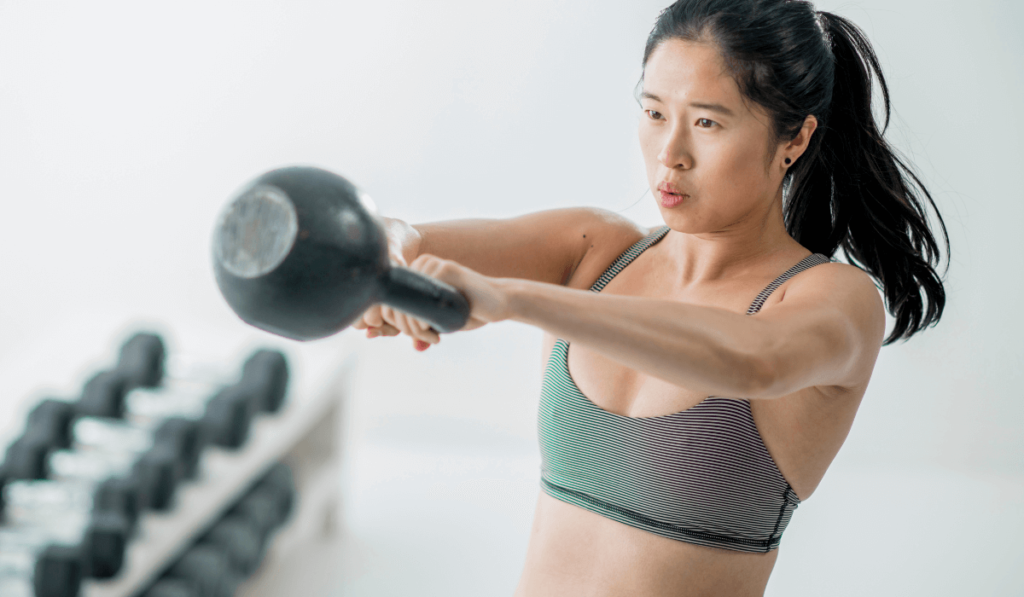
5. Think of a Broad Jump
When you’re trying to jump forward aggressively, you’re going to settle down, push your butt back and then leap forward. That is what you’re essentially training functionally with the kettlebell swing.
5 Mistakes That Prevent You From Targeting the Right Muscles
1. You Go Overhead
No matter what any crossfitter tells you. You do not need to go all the way overhead. This is not an essential move. The kettlebell swing is not a swing to a target. Also, you do not have to reach eye level.
2. You Bent your Knees Too Much
The other thing, probably the worst offense, is bent knees too much. Because at this point, we’re doing a jumping squat. The kettlebell swing is not a front raise squat.
3. You Are Distracted
The last one is that a lot of people check their proper forms. Do you think this is safe? Probably not. Distraction is the biggest cause of a lot of common mistakes while performing kettle swings.
4. You Raise Shoulders
The kettlebell swing is not a shoulder and arm exercise. If somebody’s doing a shoulder raise, they’re not using the hips for the muscle strength of the move in the momentum. The kettlebell swing is more of a hinging.
If you get a strong hip hinge and perform the full extension of the hinge, the kettlebell flings off into your shoulder. So, the kettlebell should feel as light as a feather. So, remember that it’s not a shoulder raise it’s a hip hinge.
5. Hanging the Kettlebell too Low
If you hang the kettlebell too low, you load the lower back too much and bring the shoulders lower than they have to be. It is not an efficient way of performing the kettlebell swing. The kettlebell should move through the hips as tight as possible.

How to Identify Weak Muscles in the Kettlebell Swing
A Rounded Back
The first wrong thing is a rounded back to even pick up your kettlebell. That means that your back and core are weak or not engaged. And when you try to swing it forward, you’re not using your core. And it looks very weak.
It is not only unsafe. It could injure your lower back. You do have some muscle strength there, but when you are rounding your back you lose all the tension. When you bring your shoulders back and elevate your chest, you’re keeping the tension in the muscles.
If your back hurts when you do the exercise, you need to figure out what is causing the tightness and the risk of injury. It’s usually weak back muscles, a weak core, or a poor kettlebell swing technique.
Stationary Hips
Another thing is not even letting the momentum carry your hips back. That means that your hips are not engaged or they are weak. You’re not even building that much power and you’re letting it move you. And you’re not getting the full range of motion.
Kettlebell Swing Benefits
We see new workout trends that come and go every month claiming that their method is the best ever. However, many professional athletes, trainers, and scientists have a similar conclusion – one tool that will bring results like no other is the kettle bell.
A piece of iron with a handle is the main piece of training equipment if you’re looking to get fitness results effectively and simply.
What are the actual benefits of the kettle bell swing? Here are six huge benefits that you can expect to see by targeting the right muscles while doing kettlebell swings.
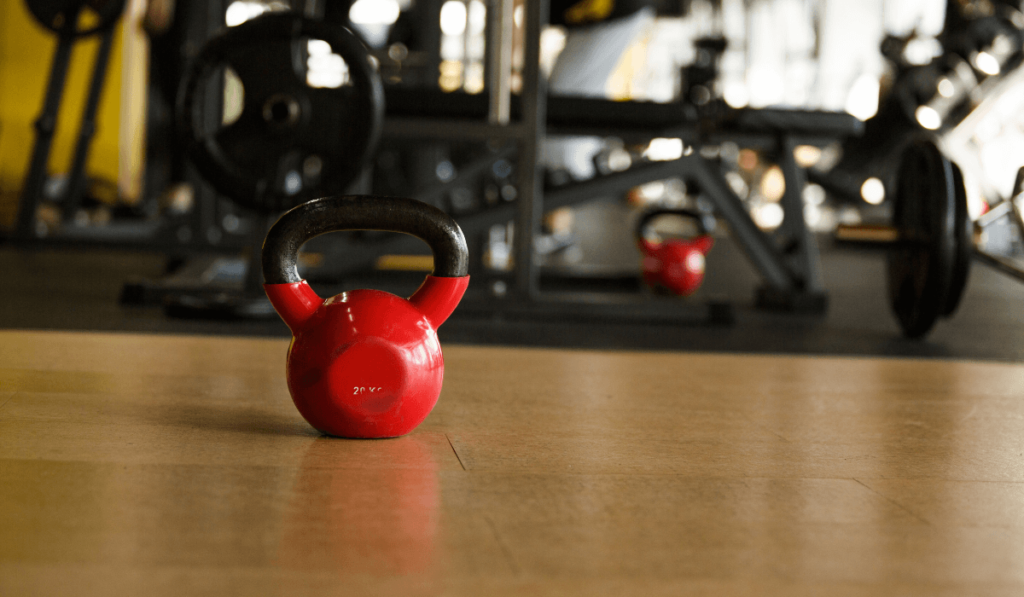
1. Improve Strength
The first benefit of consistently swinging a kettlebell is that it builds full-body power and strength. If you’re swinging heavy kettlebell weights over and over, it’s going to develop your power and strength.
There was a study posted in the Journal of Strength and Conditioning research. It tested the transference of kettlebell strength to actual strength power and muscular endurance. This study found that there was an increase in the results of participants in their clean and jerk. Also, there was an increase in their bench press.
So, kettlebell training can be effective as an alternative method to enhance strength and power during traditional weightlifting exercises.
There was a study done by Ace which found that core strength increased by 70 percent while doing the kettlebell swing.
2. Improves Cardio
One study found that by swinging for about a 20-minute workout the average participant burned approximately 20 calories per minute. If you want to compare that to another exercise, that’s about the same as running at a 6-minute mile pace.
3. Weight Loss
Kettlebell swings are much more effective at burning calories than a lot of other exercises in the fitness industry. They have some intense human-growth hormone and testosterone changes.

There’s another study published in the Journal of Strength and Conditioning. It found that testosterone was significantly higher after doing kettlebell swings. Growth hormone was higher as well. That hormonal changes allow you to build more muscles which in turn will help you burn more calories as well.
4. Strengthen Your Posterior Chain
The kettlebell swings strengthen your posterior chain and improve your general posture. There’s another study done in the Journal of Strength and Conditioning. It found that the seven participants had a very noticeable change in terms of the health of their backs.
5. Improves Balance
The kettlebell exercises improve overall balance. So if you think about this from a logical standpoint, if you’re swinging this kettlebell weight (it’s a large mass that’s moving back and forth), it is going to take some balance with your feet to be able to maintain that posture and to stay in that grounded position.
The Ace Fitness found that kettlebell workouts increase core strength, and aerobic capacity and improve dynamic balance.
6. Increased Heart Health
The same study found that kettlebell weight training also increases heart health and physical endurance. Also, by kettle bell swinging, you can speed up your fat loss and overall metabolism.
What Muscles Do Kettlebell Swings Work: FAQs
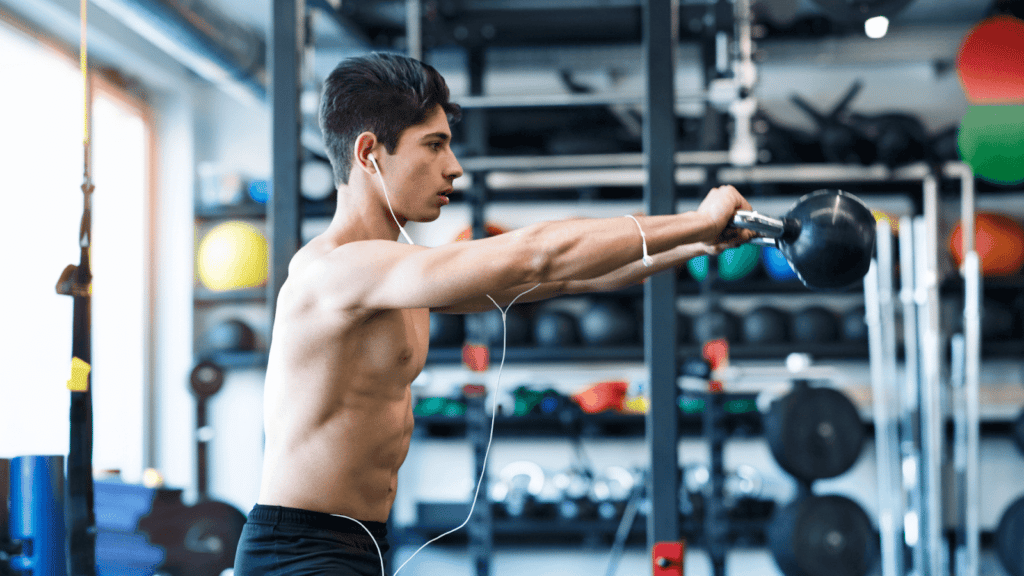
What do kettlebell swings do for your body?
Performing kettlebell swings is a great way to build strength, muscle mass, balance, flexibility, and physical endurance quickly. The kettlebell swing workout is an entire-body dynamic movement and you get a lot of huge benefits for your body in a very short time.
With a proper form, kettlebell swings strengthen the posterior chain. Many individuals credit kettlebell swings with restoring and enhancing back health and function.
What happens if you do 100 kettlebell swings a day?
The kettlebell swings will improve your general posture and strengthen your posterior chain. Also, they will improve your balance, burn calories and help you lose weight. It’s just a few of the amazing benefits you’ll receive for performing 100 kettlebell swings every day for a month. If you’re performing switching-up workout routines, you will achieve great results with minimum time spent.
Do kettlebell swings work all muscles?
The kettlebell swing works a lot of muscles. It hits almost everything in your body because it’s a full-body exercise.
The kettlebell swing is an incredible exercise for your posterior chain. When we talk about the posterior chain we’re talking about all the muscles that lie down the back of your body. The kettlebell swing works the hamstrings, glutes, erectors, quadriceps, deltoids, rhomboids, trapezius, neck muscles, and abdominal muscles. So, it is an incredible exercise for building strength in that area.
Is it OK to do kettlebell swings every day?
If there was only one exercise you could perform for the rest of your life that would give the best all-around results on your body in terms of fat loss and muscle gain, it would be the kettlebell swing.
The simplicity of the kettlebell swing makes it useful for the large majority of people. And it’s often considered to be the single greatest tool of lifting that has been invented so far.
The American Council published a study on the effect kettlebell swings have on the body. Based on comparisons with data from previous research on standard weight exercises, the heart rate and oxygen consumption responses during the kettlebell swings routine suggest that they provide a much higher intensity workout than standard weight training routines.
The kettlebell swings workout easily meets recommendations for improving aerobic capacity. So most people should include kettlebell swings in their weekly and potentially even daily routine.















